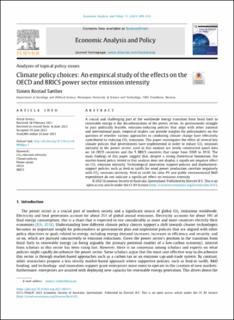| dc.contributor.author | Sæther, Simen Rostad | |
| dc.date.accessioned | 2021-11-01T14:40:16Z | |
| dc.date.available | 2021-11-01T14:40:16Z | |
| dc.date.created | 2021-09-07T09:43:26Z | |
| dc.date.issued | 2021 | |
| dc.identifier.citation | Economic Analysis and Policy. 2021, 71 (3), 499-515. | en_US |
| dc.identifier.issn | 0313-5926 | |
| dc.identifier.uri | https://hdl.handle.net/11250/2827013 | |
| dc.description.abstract | A crucial and challenging part of the worldwide energy transition from fossil fuels to renewable energy is the decarbonization of the power sector. As governments struggle to pass politically feasible, emission-reducing policies that align with other national and international goals, empirical studies can provide insights for policymakers on the question of whether various approaches to combating climate change have effectively contributed to reducing CO2 emissions. This paper investigates the effect of several key climate policies that governments have implemented in order to reduce CO2 emission intensity in the power sector; used in this analysis are newly constructed panel data on 34 OECD countries and the 5 BRICS countries that range from 2000 to 2018. The main findings of this paper suggest that, despite a strong theoretical foundation, the market-based policy tested in this analysis does not display a significant negative effect on CO2 emission intensity. Technological innovation support-policies and deployment-support policies such as feed-in tariffs for wind power production correlate negatively with CO2 emission intensity. Feed-in tariffs for solar PV and public environmental R&D expenditure do not indicate a significant effect on emission intensity. | en_US |
| dc.language.iso | eng | en_US |
| dc.publisher | Elsevier | en_US |
| dc.rights | Navngivelse 4.0 Internasjonal | * |
| dc.rights.uri | http://creativecommons.org/licenses/by/4.0/deed.no | * |
| dc.title | Climate policy choices: An empirical study of the effects on the OECD and BRICS power sector emission intensity | en_US |
| dc.type | Peer reviewed | en_US |
| dc.type | Journal article | en_US |
| dc.description.version | publishedVersion | en_US |
| dc.source.pagenumber | 499-515 | en_US |
| dc.source.volume | 71 | en_US |
| dc.source.journal | Economic Analysis and Policy | en_US |
| dc.source.issue | 3 | en_US |
| dc.identifier.doi | https://doi.org/10.1016/j.eap.2021.06.011 | |
| dc.identifier.cristin | 1931843 | |
| cristin.ispublished | true | |
| cristin.fulltext | original | |
| cristin.qualitycode | 1 | |

